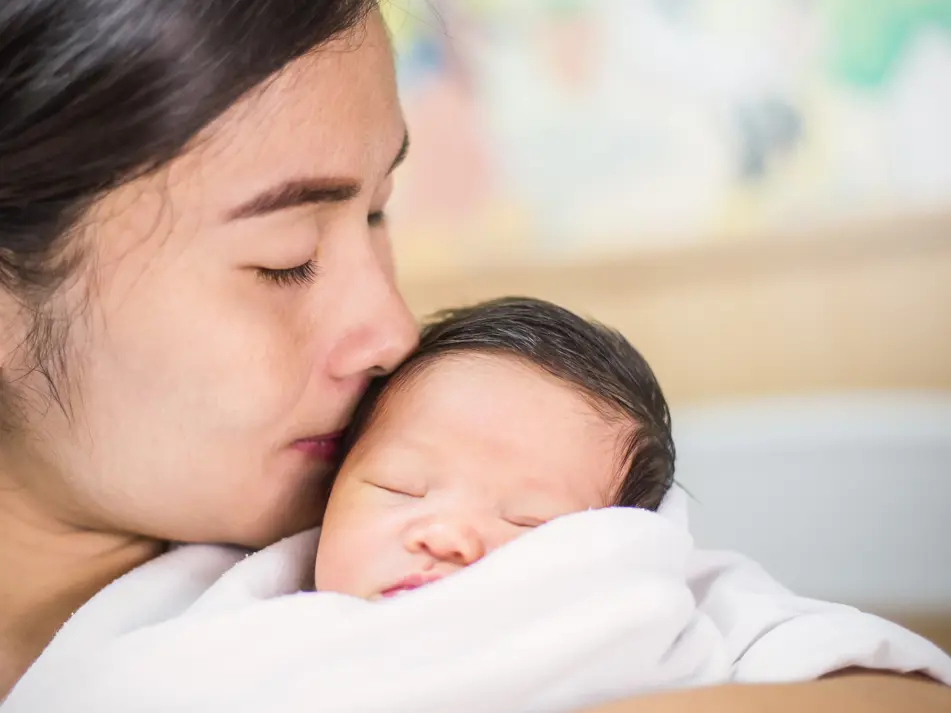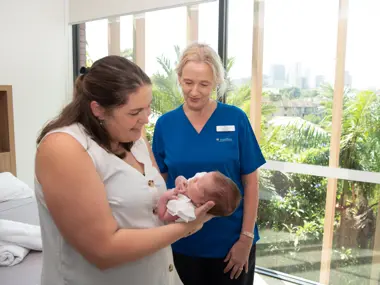Your baby is strongly influenced by the environment, daily activities and routines. A predictable routine (sequence of activities) including a wind down period (for example, meal, bath, cleaning teeth, story time, cuddle and kiss, and into the cot/bed) helps your child establish good sleep patterns.
Baby sleep cycles
During the first three months of your baby’s life, his sleep is only just starting to develop. Your new baby may sleep for 14–17 hours a day. He has periods of sleep for as little as 50 minutes to two hours of sleep, at any time of the day and night. Within these periods of sleep, he has sleep cycles. Your baby will take time to develop a sleep pattern – he needs your help with that.
When your baby sleeps, he has sleep cycles of active and quiet sleep, which, on average, last about 50 minutes, although sometimes, they can be as short as 30–40 minutes. You might notice that your baby has quite a lot of active (or dream) sleep when he sleeps. All young babies have more active sleep than older babies and children, because they aren’t awake or socialising much yet. Because he’s not getting much external stimulation for brain growth, he needs lots of dreaming sleep during this early period. It’s important that you’re not tempted to keep him awake and stimulate him. You’ll just make him an unsettled baby, sleep-deprived and grumpy.
As he grows up, he will be more wakeful, and will socialise and play with you. His active sleep cycles will reduce and he will have more quiet sleep. So there’s no need to worry – his brain and body will take care of it all. That’s why it’s helpful to know about states of consciousness.
In the early months, your baby begins his sleeps in active sleep; this means he can be more easily woken when you first put him to bed. There is no set timeframe for how long your baby will stay in active or quiet sleep, you can only work out which sleep state your baby is in by how he behaves (‘Your baby’s brain state’).
Usually, at the end of a sleep cycle, your baby stirs as he moves into a drowsy or transitional state of consciousness. This can be a little confusing – it can be hard to tell if he’s awake or not. Some babies may cry during sleep or call out at this point. If you wait to see what happens, he may manage to go back to sleep on his own; other times, he will need your help or, alternatively, he may have finished sleeping and be ready to get up, have his feed and enjoy social time.
Sleep cycles are still immature for the first three months, so he may not be able to self-soothe between sleep cycles without your help, or sleep for longer than two to three hours at one stretch, day or night.
Case Study
By three months, your baby reaches a big turning point. If you have managed to help him organise his day–night rhythms, he will spend less time in active sleep and more time in quiet sleep during the daytime. This is because he spends more time awake and enjoys more social time with you. Once he starts to receive lots of loving attention through games, play and social encounters with you, he won’t need to dream so much.
States of consciousness and sleep cycles work together because the active sleep and transitional drowsy stages are associated with waking and the ability to self-soothe. Often, this is where sleep difficulties occur.
Here’s a common situation, where it’s really easy to confuse parts of your baby’s sleep cycles, and drowsy and awake states.
Case study: The cat-napper
Your one-month-old baby has fallen asleep straight after his feed. You notice that he seems still, quiet and deeply asleep, so you put him into his cot and tiptoe away. He stays asleep for 40 minutes, then you hear him stirring. Is he awake now? Is it time to get him up? Is 40 minutes enough sleep? You’re not sure, so you go and have a look.
When you see him, he’s moving about a little and his eyes are opening and closing. You wait and watch because you’re really not sure what he’s doing. Then you see him open and close his eyes, and he pouts and squirms a little. He seems like he’s awake now. You don’t want him to cry, so you go and pick him up before he gets upset. You wonder whether he might be hungry again, or lonely, or have a pain in his tummy. Maybe he doesn’t need any more sleep?
You take him out of his cot and back into the brightly lit living area. The TV is on while you change his nappy and talk to him in an upbeat way to cheer him up. He watches you closely, but his movements seem jerky. He’s fussy and yawns. By the time you’ve finished the nappy change, he’s fully awake but not very sociable. He doesn’t seem hungry but you decide to feed him anyway, just in case. He takes a small feed then, after fussing and crying for half an hour, he falls asleep in your arms. You decide to put him back into his cot to see if he’ll have a longer sleep. He wakes up again after 40 minutes and you go through the whole routine again.
So, what happened? Did you recognise any of his states of consciousness? When he woke up after 40 minutes, he was probably at the end of a sleep cycle and was in a transitional drowsy state. If you had waited a moment or tried to resettle him (which we’ll talk about in a moment), he may have gone back to sleep.
When we mix up our baby’s states of consciousness, we risk interrupting his sleep, getting him up to feed or socialise when he isn’t ready. The result can be that the baby becomes physiologically disorganised. When that happens, the baby’s behaviour becomes disorganised as well, and he’ll show you by becoming tired, grumpy and may not feed well.
Here’s what’s considered to be normal sleep patterns for the first three months.
Newborn to six weeks
Six to eight regularly occurring periods of sleep, lasting two to four hours around the clock. Your baby has no day–night pattern yet.
Babies have short and sometimes frequent periods of wakefulness for a feed, short socialisation or resettle.
The day–night pattern emerges by about four weeks, sometimes longer, if your baby is exposed to bright light levels at the wrong time of day.
Six weeks to three months
One period of sustained sleep for four to five hours during the night, when your baby may begin to self-settle. During his long sleep, your baby will have one to three brief awakenings.
Your baby will wake at least one to three times during both day and night sleeps, and need help resettling.
At about six weeks, sleep begins to become more concentrated into the night-time hours and your baby is more awake during the day.
Three months onwards
By 12 weeks, your baby will have established a clear day– night pattern.
In the first three months, 95 per cent of babies will cry when waking and need to be resettled back to sleep, and this resettling may be separate from a feed time.
Remember that you cannot control your baby’s sleep. You can’t teach or train him to sleep to a special one-size-fits-all ‘sleep prescription’, which you might have read in a book or found online, especially when he’s less than three months old.
Sleep cycles explained
Apart from the day–night circadian sleep cycle, your baby has another type of sleep cycle to develop. The second sleep cycle occurs during your baby’s periods of sleep. Both the sleep and awake states have their own particular physical and behavioural patterns. Your baby’s sleep cycles are divided up into two distinct ‘sleep states’. You’re probably familiar with the terms rapid eye movement (REM) or dream sleep, and non-rapid eye movement (non-REM) or deep sleep. These are what the adult sleep states are called. Our baby’s sleep states are called ‘active sleep’ (dreaming) instead of REM and ‘quiet sleep’ instead of non-REM.
Your baby already had periods of active sleep and quiet sleep in the months before birth. You may have been aware of those times when your baby was asleep in your womb. In fact, by paying close attention to when she’s asleep and awake during the last month of pregnancy, you can actually predict what her daily sleep patterns are going to be after birth. If she’s awake and busy between 2 am and 4 am, then she’s likely to be wakeful around that time after she’s born. The good thing about that is she’s giving you a heads up while you’re pregnant; that way you can be prepared and arrange your day so you can get some rest after her arrival.
Once she’s born, her sleep continues to develop internally in response to her own brain and body. What’s more important, her sleep is also impacted on by what’s happening in her environment and how you help her to sleep. You’re a team when it comes to helping your baby gradually develop her ability to sleep longer and soothe herself to sleep. Your baby is not unconscious when she’s asleep. During those early weeks when she’s mostly asleep, her brain is highly active and dreaming during sleep. She needs to dream because as she isn’t awake much and unable to socialise, this helps her brain to grow. But this doesn’t mean you should keep her awake and socialise with her – she needs all that sleep. She will socialise at exactly the right time and when she needs to.
As she becomes more wakeful and socialises and plays with you, her social brain will get more stimulation from you and she won’t have to dream as much. This means her brain is growing. By the way, did you know that humans have a social brain? Our brain is wired up to want to be with people. The most important things you can do for your baby’s brain development are to talk to her, smile, laugh, play and learn her non-verbal language so you can understand how she communicates with you.
During these early weeks, your baby has much more dream or active sleep than you do. She is different from you though, because your baby begins her sleep in active or dream sleep and then spends equal times in quiet and active sleep. These episodes of quiet and active sleep alternate for 50 to 60 minutes. This is what is generally known as a sleep cycle. When she’s younger than 3 months, your baby’s active sleep is different to yours. Think about when you dream (your REM/active sleep). You don’t move about much, unless you have a nightmare and wake up startled. You may wake after you dream, but you usually go back to sleep.
If you watch your baby sleep, you’ll see during quiet sleep that she won’t move much at all and might be difficult to rouse. During active sleep, she’ll move her arms and legs, suck and smile. This can be confusing for you because you may think she’s awake. Even more confusing, at the end of active sleep, you’ll see that your baby usually stirs as she moves into a transitional state and seems as if she might be awake. This is when she might cry and call out. Sometimes she will manage to go back to sleep, other times she will need your help.
The most important things you can do for your baby’s brain development are to talk to her, smile, laugh, play with her and learn her non-verbal language.
Until she’s 3 months of age, her sleep cycles are still very immature, so she may not be able to self-soothe and sleep for long periods without your help. By 3 months, your baby will spend less time in active sleep during the daytime because she is awake and much more sociable. Her brain is getting stimulation from the outside world, so she doesn’t need to dream so much. She spends more time in quiet sleep during the day and night, and she begins sleep in quiet sleep. At this age, she moves her arms and legs less in active sleep, so that’s less confusing for you. The more time your baby spends awake, active and sociable, the less active sleep she’ll have during the day.
From 3 months, her active and quiet sleep continues to mature. Sleep cycles remain at 50 to 60 minutes in length. Her sleep changes at night as well, with quiet sleep dominating the sleep cycles at the beginning of the night and active sleep dominating the cycles in the early hours of the morning.
It’s good to understand how sleep cycles work because active sleep is associated with waking and the ability to self-soothe as your baby grows and develops. This is where sleep difficulties often occur.
Now, you are probably very interested in understanding how to get your baby to sleep through the night. ‘Hooray!’ you say. ‘At last! Please tell me what I need to do!’ Here’s the problem: if you’re expecting your baby to sleep 10 to 12 hours without waking, you should know that most babies don’t actually do that. So, the first thing you need to understand is why your baby doesn’t usually sleep 10 to 12 hours without waking through the night. If you don’t understand how your baby’s sleep develops, then you might keep expecting something unrealistic of her and, when that doesn’t happen, you’ll feel angry, upset and disappointed. If that happens, you won’t enjoy your baby. Your baby needs you to enjoy her and delight in her.
So far, we’ve been telling you about important internal developmental processes that are occurring in your baby’s first three months, which you have no control over. We hope this will ease your mind a little because now you know that, just as your baby will develop in so many other ways, she will also develop in relation to her sleep. On the flip side, there are lots of external influences on your baby’s sleep in which you play an important role. We’ve already talked about circadian rhythms and melatonin and how you can help with those, so let’s keep going and move on to her sleeping through the night.






































